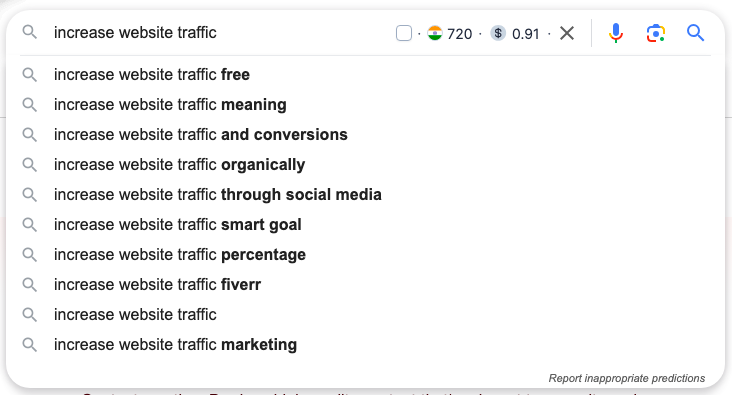13 Keyword Research Checklist for Boosting Your Website Traffic Organically

As an online business owner or digital marketer, you understand the importance of driving organic traffic to your website. One of the best ways to do this is by doing keyword research. By identifying the right keywords to target, you can optimize your website content and improve your chances of ranking higher in search engine results. In this comprehensive keyword research checklist, we will guide you through the essential steps to boost your website traffic organically. Follow this checklist carefully and take your website to new heights.
The Importance of Keyword Research
Before we discuss the specifics of keyword research, it’s important to understand why it’s so important to your website’s success. Keywords are words or phrases that users enter into search engines when looking for information, products, or services. By targeting the right keywords, you can ensure that your website appears in search engine results when potential customers are actively searching for what you offer.
Keyword research helps you discover words and phrases that are closely related to your business and have a high search volume. When you use these keywords wisely in your website content, you can boost your chances of showing up higher in search engine results. This helps you drive more organic traffic to your website, increase brand visibility, and ultimately increase your conversions.
13 Keyword Research Checklist for Increase Website Traffic
Some important points should be considered and not skipped while doing keyword research. These are the following:
1. Brainstorm Seed Keywords
The first step in your keyword research checklist is to brainstorm seed keywords. These are the basic keywords that are relevant to your business, industry or blog. Start by thinking about the main topics or themes that are associated with your website. For example, if you have an online store that sells organic skincare products, your seed keywords could include “organic skincare,” “natural beauty,” and so on.
Once you have a list of seed keywords, you can expand on them by using keyword research tools. These tools will help you uncover related keywords and phrases that have a high search volume. Some popular keyword research tools include Google Keyword Planner, SEMrush, and Ahrefs. Enter your seed keywords into these tools, and they will generate a list of related keywords that you can consider targeting.
2. Search Your Main Keyword in the Search Bar

Once you have your seed keywords, it’s time to start expanding your list by leveraging the power of search engines. Take one of your seed keywords and enter it into the search bar of a search engine like Google. As you type, the search engine’s autocomplete feature will suggest related search terms.
These suggestions are a gold mine for a keyword research checklist. They provide valuable information about what other users are searching for when they enter the same keywords. Take note of these suggestions as they can help you find additional keywords being used by your target audience.
3. Define Your Target Audience
Before you proceed any further in your keyword research checklist, it’s crucial to define your target audience. Understanding your audience’s needs, preferences, and search behavior will help you choose the right keywords to target. Consider factors such as interests, gender, age, location and pain points.
Once you have a clear picture of your target audience, you can start tailoring your keyword research to match their needs. For example, if you’re selling workout gear for women in their 30s, you should look for keywords that this group might use, like “women’s fitness gear” or “exercise equipment for women.”
4. Using Keyword Research Tools
Now that you have a list of seed keywords and have defined your target audience, it’s time to leverage keyword research tools to further refine your keyword list. These tools provide valuable data on search volume, competition, and other metrics that can help you make informed decisions about which keywords to target.
Start by entering your seed keywords into your chosen keyword research tool. Analyze the data provided, paying attention to metrics such as search volume, keyword difficulty, and cost-per-click (CPC).
- Search volume lets you know how many people are searching for a specific keyword.
- Keyword difficulty shows how difficult it is to get your website to rank high for a specific keyword.
- CPC gives you an idea of how much advertisers are willing to pay for clicks on ads related to that keyword.
5. Find a Primary Keyword to Target
Once you have completed the process of refining your list of keywords using the keyword research checklist, the next step is to select a primary keyword for each page on your website or blog. The primary keyword is the focus keyword for a specific page or blog’s content. It should accurately represent the main topic or purpose of that page.
When choosing a primary keyword, consider its relevance to the content, search volume, competition, and search intent. Understanding the search intent behind your primary keyword will help you create content that resonates with your audience’s needs and preferences.
6. Research Related Keywords
Once you have a clear understanding of your target audience, it’s time to further expand your keyword list by researching related keywords. Related keywords are words or phrases that are very closely related to your seed keyword, but may have a slightly different focus or intent.
There are several tools available that can assist you in finding related keywords. Some popular options include Google Keyword Planner, SEMrush, and Ahrefs Keyword Explorer. These tools provide valuable insights into keyword search volume, competition, and related terms.
7. Identify Long-Tail Keywords
Long-tail keywords are longer, more specific search queries that typically have a lower search volume but higher intent. While they may not drive as much traffic individually, they can be highly targeted and are more likely to lead to a conversion.
To identify long-tail keywords, consider the pain points, questions, or specific needs of your target audience. Think about the phrases they might use when searching for solutions or information. Long-tail keywords can help you capture highly targeted traffic and improve your chances of ranking higher in SERPs.
8. Check the Volume and Difficulty of Your Keywords
Volume and difficulty are two critical factors to consider when selecting keywords. Volume means how many times people search for a keyword every month on average. Higher volume keywords generally indicate higher search demand.
On the other hand, keyword difficulty refers to how challenging it is to rank for a particular keyword. It takes into account factors such as competition, domain authority, and backlink profiles of websites already ranking for that keyword. It’s important to maintain a balance between volume and difficulty, so you can target keywords that have enough search demand and are achievable within your website’s SEO capabilities.
9. Organize Keywords into Groups
To optimize your content effectively, it’s essential to organize your keywords into groups or clusters. Grouping keywords allows you to create focused content around specific topics and improve your website’s overall SEO. Start by categorizing your keywords based on their relevance and similarity.
For example, if you have a fitness blog, you might create keyword groups for “weight loss tips,” “healthy recipes,” and “workout routines.” This will help you create targeted content that caters to different user needs and search intents.
10. Optimize Your Content
Now that you have your keyword groups, it’s time to optimize your website’s content. Start by incorporating your target keywords naturally into your page titles, headings, meta descriptions, and body content. Ensure that the keywords flow naturally and provide value to the reader.
Don’t stuff your content with too many keywords. This means don’t overuse them to trick search engines into ranking your page higher. Search engines have become smarter at detecting this practice, and it can result in penalties that harm your website’s visibility.
11. Analyze Your Competitors’ Strategies
Your competitors can provide valuable insights into successful keyword strategies. By analyzing their websites, content, and keywords, you can identify opportunities and gaps in your own strategy.
Start by identifying your main competitors. These are the websites that appear at the top when people search for the terms you want. Visit their websites and assess their content, meta tags, and other SEO elements. Look for the keywords they are targeting and how they have optimized their content around these keywords.
12. Monitor Keyword Performance
Keyword research is an ongoing process, and it’s essential to monitor the performance of your keywords regularly. By tracking keyword rankings, search volume trends, and changes in keyword difficulty, you can adapt your SEO strategy accordingly.
Use tools like Google Analytics and Google Search Console to gain insights into how your keywords are performing. Identify keywords that are driving significant traffic and conversions, as well as keywords that may require further optimization. Regular monitoring allows you to stay ahead of the competition and make data-driven decisions to improve your organic traffic.
13. Analyze Your Audience to Identify Their Needs
It’s important to continuously analyze your audience to gain a deeper understanding of their needs. Use analytics tools to gather data on user behaviour, such as which keywords are driving the most traffic to your website, which pages have the highest bounce rate, and which keywords are leading to conversions.
By analyzing this data, you can identify patterns and trends that will guide your keyword research strategy. For example, if you notice that a particular keyword is driving a significant amount of traffic but has a low conversion rate, it may indicate that the keyword is not aligned with your audience’s needs or that your content needs optimization.
Conclusion
Keyword research is super important for making your SEO plan work well. By following this keyword research checklist diligently, you can identify the right keywords to target and optimize your website content to drive organic traffic. Remember to understand your target audience, research-related and long-tail keywords, analyze your competitor’s strategies, and monitor keyword performance regularly.
By optimizing your website for the right keywords, you can significantly increase your organic traffic and unlock the full potential of your online presence. Happy researching!






